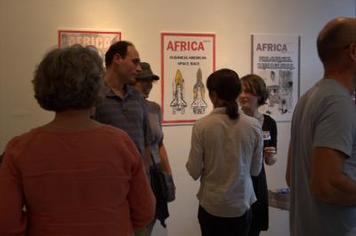
"Can you believe all of this extra security??" was one of the many initial reactions to the opening of Sites of Passage last Friday, Sept. 9, 2011. What many visitors did not realize (until later), was that the "security" was really made up of American artists posing as officers in collaboration with Sudanese artist Amado al Fadni's installation "Passport Agency".
The idea was to subject Americans to the absurdity of bureaucratic processing which is often the norm for citizens in the Middle East when trying to come to America. In the run-around, unknowing participants in this act filled out a questionnaire in order to obtain a faux passport, and then were quizzed by artist officers, like Larry Bogad, about their hopes, dreams, and fears in order to obtain an entry visa to the show. Depending on the answers, some passed through freely, while others were sent on to more stamping scrutiny.
"How long have you lived here?" asked artist officer Mark Staley.
"My whole life," answered the unsuspecting visitor.
"Wow, here in this museum?" Mark reprised as he put on a second pair of glasses to inspect the documentation. Others in line chuckled.
"I just want to get in and see the show," another applicant complained while being shuffled between stations. "You should really talk to each other more so you can iron out all of these kinks," she advised.
The idea was to subject Americans to the absurdity of bureaucratic processing which is often the norm for citizens in the Middle East when trying to come to America. In the run-around, unknowing participants in this act filled out a questionnaire in order to obtain a faux passport, and then were quizzed by artist officers, like Larry Bogad, about their hopes, dreams, and fears in order to obtain an entry visa to the show. Depending on the answers, some passed through freely, while others were sent on to more stamping scrutiny.
"How long have you lived here?" asked artist officer Mark Staley.
"My whole life," answered the unsuspecting visitor.
"Wow, here in this museum?" Mark reprised as he put on a second pair of glasses to inspect the documentation. Others in line chuckled.
"I just want to get in and see the show," another applicant complained while being shuffled between stations. "You should really talk to each other more so you can iron out all of these kinks," she advised.
| Once visitors finally passed through the rush of Mad Libs, the stage opened up to explore over a dozen installations ranging from videos exploring nationalism, sound installations about unity, Arabic calligraphy, and some unique photography. To view some of the current work, visit our Online Gallery and click on each piece individually to leave comments. With over 350 in attendance, a buzz of excitement spread thick through the halls of The Mattress Factory Museum's Annex building. Many of the American artists who participated in the Fayoum Workshop were busy sharing stories from their experience of living in a Revolutionary countryside for 3 weeks, while some Pittsburgh locals shared their interpretations of work with complete strangers over food and drink. | |
Besides the insidious greeting of "Passport Agency", one installation of high note became "Tahrir (squared)" by Emily Lychack. Featuring rocks from the actual square where the revolution took place, along with a full-round of blown up photos of protestors, the space took on the flavor of actually being in Tahrir as visitors crowded to merge into the scenery. It quickly transformed into a great place for visitors to share their memories of the not-so-distant media frenzy.
And this was the aim all along: to get people talking about global issues; sharing ideas about possibility; discussing the world we live in order to understand new vantage points.
"I am very pleased with how all of this turned out," noted Firefly Tunnels creator Tavia La Follette. "I mean, obviously there were some major issues with the Egyptians not being here right now, but look at how we managed!" she expressed, pointing to the slew of visitors publically engaged in internationally curated art.
Sites of Passage will run until January 8, 2012. For more information about upcoming programs and events, see our MAIN PAGE.
And this was the aim all along: to get people talking about global issues; sharing ideas about possibility; discussing the world we live in order to understand new vantage points.
"I am very pleased with how all of this turned out," noted Firefly Tunnels creator Tavia La Follette. "I mean, obviously there were some major issues with the Egyptians not being here right now, but look at how we managed!" she expressed, pointing to the slew of visitors publically engaged in internationally curated art.
Sites of Passage will run until January 8, 2012. For more information about upcoming programs and events, see our MAIN PAGE.
 RSS Feed
RSS Feed